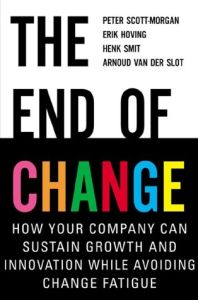Melden Sie sich bei getAbstract an, um die Zusammenfassung zu erhalten.

Melden Sie sich bei getAbstract an, um die Zusammenfassung zu erhalten.
Peter Scott-Morgan, Erik Hoving, Henk Smit and Arnoud Van Der Slott
The End of Change
How Your Company Can Sustain Growth and Innovation While Avoiding Change Fatigue
McGraw-Hill, 2000
Was ist drin?
If you’re searching for the latest method to introduce radical change to your company, it’s probably already too late.
Recommendation
If the wildly successful Who Moved My Cheese? represents the kindergarten version of basic change management theory, The End of Change makes a welcomed leap to graduate-level studies. Authors Peter Scott-Morgan, Erik Hoving, Henk Smith and Arnoud Van Der Slot maintain that many of the concepts intrinsic in the current genre of change management are just plain wrong. In reality, companies that successfully manage change do so by building structures specifically designed to induce and digest change into their overall organizations. In order to explain these structures, the authors present them in the form of geometric shapes - a metaphor that is easy to grasp and easily captures the essence of each strategy. These graphic examples are reinforced with real-life examples of companies and industries that manage change in ways that closely resemble the book’s shape-based techniques. getAbstract recommends that all executives and students read this book, which takes a sophisticated approach to a topic that has been addressed by a slew of authors and consultants-turned-authors on the most superficial of levels.
Summary
About the Authors
Peter Scott-Morgan, a speaker, consultant and teacher, is the author of the Unwritten Rules of the Game A well-known authority on managing revolutionary transformation in business, he is a partner in the international consultancy Arthur D. Little, Inc., and professor of business at Boston’s ADL School of Management. Erik Hoving, Henk Smith and Arnoud Van Der Slot are partners in the Rotterdam office of Arthur D. Little, Inc.

















Comment on this summary